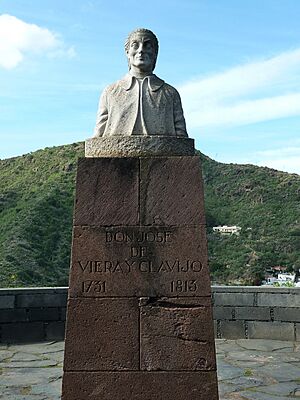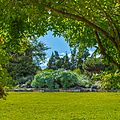Jardín Botánico Canario Viera y Clavijo facts for kids
Jardín Botánico Canario Viera y Clavijo is the full name of a special botanical garden on Gran Canaria. This island is one of the beautiful Canary Islands.
The name "Jardín Botánico Canario" means "Botanical Garden of the Canaries." The extra words "Viera y Clavijo" honor a Spanish scholar named José Viera y Clavijo (1731–1813). He tried to start a botanical garden in the Canary Islands many years ago.
This garden is located in the northeast part of Gran Canaria. It's in a place called Tafira Alta. This is about 7 kilometers (4.3 miles) southwest of the capital city, Las Palmas. It's a bit inland from Las Palmas, not far from Santa Brígida.
Contents
History of the Garden
Creating this botanical garden was the life's work of a Swedish-Spanish botanist. His name was Erik Ragnar Svensson (1910–1973). He spent many years looking for the perfect spot. He wanted a place that could grow many different kinds of plants from the Canary Islands.
He finally chose a steep slope in the Barranco de Guiniguada area. This spot was near Tafira Alta. It had a waterfall and small caves in the cliffs. Work on building the garden started in 1952. The Jardín Botánico Canario Viera y Clavijo officially opened in 1959.
Erik Svensson was the garden's first director. After he passed away in 1973, David Bramwell became the new director in 1974.
What You Can See at the Garden
The garden covers about 27 acres (10 hectares) of land. It grows around 500 plant species that are unique to the Canary Islands. This means they only grow naturally here.
Some important parts of the garden include:
- The "Garden of the Islands" (Jardín de las Islas).
- The "Garden of Cacti and Succulents" (Jardín de Cactus y Suculentas). Here you can see about 10,000 different types of succulents. These are plants that store water in their leaves or stems.
- The "Macaronesian Ornamental Garden" (Jardín Macaronésico Ornamental).
- The “Hidden Garden” (El Jardín Escondido), which has a greenhouse.
You can also find the pinetum (El Pínar), which is a collection of pine trees. There are also "Laurel-leaved Forests" (Bosque de Laurísílva). These forests have trees that once covered most of the Macaronesia islands before people settled there.
At the "Fountain of the Wisemen" (La Fuente de Los Sabios), the garden honors botanists. These are scientists who discovered and described the plants of the Canary Islands.
Helping Plants Survive
In 1983, the garden started a special seed bank. This bank stores seeds from about 400 tree species. These trees are unique to the Canaries and other Macaronesian islands. Later, they also created a germplasm bank. This bank stores other plant genetic material.
Botanists working at the garden have found and described many new plant species. The garden also helps protect endangered plants through its research. It has a library, a herbarium (a collection of dried plants), and laboratories. The garden also publishes its own science magazine called Botánica Macaronésica.
The garden is open for visitors all year round.
Gallery
See also
 In Spanish: Jardín botánico Viera y Clavijo para niños
In Spanish: Jardín botánico Viera y Clavijo para niños














